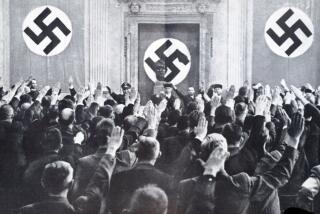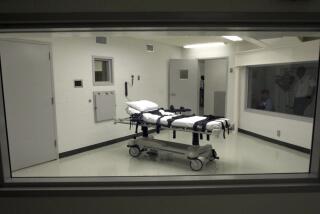Portrait of a Mass Killer : Researchers Find Many Similarities Among Modern-Day Murderers
- Share via
He led a life of frustration and failure.
He apparently felt threatened by a breakup of his family, a “precipitating event” similar to unemployment or divorce.
He was a loner--living in a state of “social isolation.”
He was familiar with and had access to firearms.
This four-point profile, developed by two Northeastern University sociologists, is a rough sketch of a troubling--some say baffling--phenomenon that seemed to dominate the headlines for much of December: the mass murderer.
R. Gene Simmons Sr., the 47-year-old former Air Force sergeant who allegedly killed 14 family members and two others in Arkansas over the holidays and then said, “I’ve gotten everybody who wanted to hurt me,” would appear to fit the profile, which matches other rampage murderers.
Older Than Typical Single-Victim Killer
Simmons apparently had moved around a lot and is older than the typical single-victim murderer, who generally is a male in his late teens or early 20s.
A majority of mass murderers have been white, mobile males in their late 20s to 40s, according to Jack Levin, one of the sociologists at Northeastern and co-author with colleague James Fox of a 1985 book, “Mass Murder: America’s Growing Menace.”
“It takes a long-standing, cumulative set of frustrations (to make a mass killer),” Levin said.
Levin, Fox and others who study the phenomenon--and have, in one instance, even categorized the types of mass killers--have had ample opportunity in the past few months, especially as 1987 waned.
Beginning Dec. 7--when 43 people died in a Pacific Southwest Airlines crash, apparently because a fired airline employee followed his ex-boss on board--a spate of mass killings has flooded the media, including the deaths of four in Texas and a possible “copycat” murder-suicide of seven family members in a small Iowa town.
Three Other Incidents
Earlier in the year, at least three other incidents drew national attention. In April, a gunman, 60-year-old William B. Cruse, randomly killed six people and wounded 10 in Palm Bay, Fla. In July eight family members in the Tacoma, Wash., area were killed by Daniel Patrick Lynam, 36, who shot his parents, his parents-in-law, his wife, his two children and then himself. In September, seven family members, including four children, were killed in Elkland, Mo. Police arrested John Schnick in the case after Schnick tried to blame a 14-year-old nephew in the deaths.
Recent mass murders, Levin said, represent “an unprecedented clustering,” adding, “I have never seen anything like this.”
Levin and others say they don’t know why the tempo of mass murders--at least well-publicized ones--appears to have speeded up, particularly in this decade--or if it has at all. Some argue that mass murders are such relatively rare--and historically poorly documented--events that it is foolhardy to draw any general conclusions about mass killers.
“The data about these phenomena are so limited that expert opinion can be nothing more than speculative,” said Stephen J. Morse, a professor of law, psychology and psychiatry at USC.
And Fox and Levin acknowledge that their profile presents an unfocused picture at best. “There are hundreds of thousands of people who fit the profile of a mass murderer,” said Fox, reiterating a point also made by Morse.
Lawrence W. Sherman, a criminologist at the University of Maryland and president of a crime research institute, was one of several who theorized that the economic and social upheavals of the last two decades may be a factor in modern mass murders in the nation. Particularly in this decade, he said, “there’s been a whole lot of restructuring of industry and downward mobility for Americans as a whole.”
The Unemployment Factor
In cases where unemployment appears to be a factor in triggering a mass killer--as in the PSA flight and the Aug. 20, 1986, Edmond, Okla., slayings of 14 co-workers by postal worker Patrick Sherrill, 44, who authorities say was about to be fired--Sherman said murderers may have “lost their sense of self-worth and superiority to the underclass who don’t work at all--and killing people is one way to assert dominance.”
In research completed since the publication of their book, Levin said he and Fox had counted 364 multiple-murder (four or more) cases, involving 1,770 victims, in the years from 1976 through 1985.
For years prior to 1976 evidence is sketchy, Levin said, although he declared that 24-year-old Richard Speck’s stabbing/strangulation murders of eight student nurses on July 14, 1966, “was basically the onset of an age of mass murder.” (A little more than two weeks later, 16 people were killed in Austin, Tex., by Charles Whitman, 25, who shot most after climbing to the top of a tower at the University of Texas.)
Levin estimated that currently there are 30 to 40 cases a year of mass murder in this country, or an average of about three per month.
Park Elliott Dietz, an associate professor of law at the University of Virginia and a forensic psychiatrist and criminologist who works with the FBI on unusual crimes, is skeptical that mass murders are on the rise.
“There’s no evidence of an increase,” Dietz said. But the frequency with which he gets calls on new instances of mass killing is “hard to ignore anymore,” he said.
Dietz himself has developed a list of three types of mass killers.
The most common kind of mass murderers are “the family annihilators” who “often are not newsworthy” beyond their local area, Dietz said. These killers often kill pets as well as their family and themselves.
Family annihilators “almost uniformly have some sort of mental illness--depression and paranoia--which leads them to believe this (murder) is a solution to a dilemma,” Dietz said. He added, “They always have trouble seeing the options.”
Family killers, especially those who do not commit suicide, may be narcissistic, Dietz said. Such killers may choose death for their loved ones because they believe “it would hurt the family too much if I died,” he explained.
Dietz has tagged the second most frequent kind of mass killer “the pseudo-commando.” These killers--such as out-of-work security guard James Oliver Huberty, 41, who killed 20 people at a McDonald’s restaurant in San Ysidro, Calif., in July, 1984--usually own “multiple firearms and have a fascination with arms,” he said. Huberty was killed by a police sharpshooter.
When pseudo-commandos go on their killing sprees they are wearing “some element of military clothing” and they probably have “fantasized about the glory of mass murder,” Dietz said.
These killers generally are discontent with society at large rather than specific individuals, Dietz and others said.
“If they’re not angry at any particular person, they go after people in general,” said Northeastern’s Fox.
A Hazy Distinction
His colleague Levin added, “I think that the more random the massacre, the more likely the killer is to be psychiatrically insane.”
Sometimes the distinction between targets appears to be hazy, said Dr. Alfred Coodley, professor emeritus of psychiatry at USC. In the case of last month’s Pacific Southwest Airlines crash, David Burke, 35, a fired airline employee who apparently caused the crash, probably shot his boss and then caused the death of himself and 41 others because everyone on the airliner was “joined together in his mind as the major heavies in the piece,” Coodley said.
Dietz’s third--and rarest--category of mass murderers are “set and run killers” who use some lethal method--arson, bombing, product tampering--that allows them to escape. Unlike the previous two groups, these killers--such as the Tylenol poisoner who killed seven in Chicago in 1982--may have no serious mental disorder and are motivated by revenge and anger, Dietz said. In another such case, 45 people, including 38 elementary school students were killed in a series of dynamite explosions at the Bath, Mich., Consolidated School. However, the bomber, school board member Andrew Kehoe, then blew himself up, along with the school superintendent.
While the mental processes of mass killers largely remain an enigma and while their actions probably never will be predictable, several experts said that today’s availability of military-style weapons and firearms in general may be important in some massacres.
“One explanation might be that in the past killers would have just used knives or other less effective technologies,” criminologist Sherman said.
More to Read
Sign up for Essential California
The most important California stories and recommendations in your inbox every morning.
You may occasionally receive promotional content from the Los Angeles Times.













